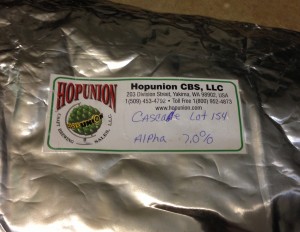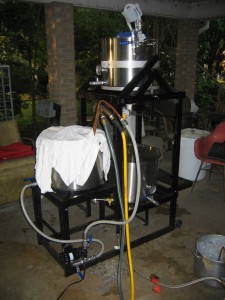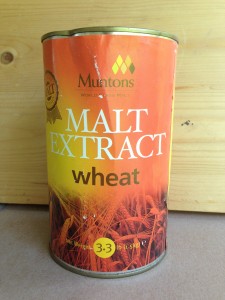This is the second of two articles on extract wort production in the series of articles on barleywine. The previous article was published yesterday.
Making a barleywine wort using malt extract as the primary source of fermentables is straightforward — for the most part, you just dissolve the malt extract in water. However — as I discussed in the previous article on influencing the amount of trub and altering the fermentability of the wort — there are ways to tweak your wort production to make brewday easier and your beer better.
Minerals
Some homebrew barleywine recipes — and especially old-school English barleywine recipes — call for large additions of gypsum or Burton salts. (Burton salts are a blend of minerals meant to imitate the water profile of Burton-on-Trent, a famous English brewing city known for its hoppy beers.) In most cases, this is not advisable. Whatever minerals were present in the wort that became the malt extract will be in your extract wort. And, given the high density of the wort, the minerals will be at correspondingly higher concentrations than in a lower-gravity wort. In addition, the minerals from your partial mash wort will also end up in your barleywine wort. If you’d like to accentuate the hop character of your barleywine, add up to 2 tsp. of gypsum per 5 gallons (19 L) of beer. Don’t add more unless you’ve brewed the beer before and determined that it needs it. (Note: you can add gypsum at bottling, if needed.)
Hops

You’ll need plenty of hops for your barleywine, so use them efficiently. Hops boiled for 60–90 minutes yield about as much iso-alpha acids as possible (through boiling). Hops added very late in the boil — especially at knockout — add the maximum amount of aroma.
Barleywines are hoppy beers. As such, the amount of wort lost to hop debris in the kettle can be substantial. And, if you’re boiling less than a full wort, that volume of wort would have been diluted to make even more beer. As such, it’s important to get the most from your hops. That’s why, for making stovetop extract barleywines, I recommend taking the “bookend” approach to hopping. Add your bittering hops at the beginning of the boil and boil for 60 minutes (or even up to 90 minutes). In this way, you’ll extract the highest amount of alpha acids from them. (Also, use high-alpha hops for bittering.) In addition, add all of your aroma hops at knockout. This way you’ll get the maximum amount of hops oils from them. Adding hops in between results in both lower hop utilization (less extraction of iso-alpha acids) and a greater evaporation of hop oils. Adding hops at the beginning and the end of the boil maximizes the amount of “good stuff” (iso-alpha acids and hop oils) you get from the hops, while minimizing the amount of plant material you add to the kettle.
Boil Volume and Double Fills
You should boil as much wort as possible, up to a full-wort boil, when making an extract barleywine. If your brewpot size or heat source limit the amount of wort you can boil vigorously, consider making your wort in two (or more) shifts. Or use separate pots and boil simultaneously, if you can. For a beer this big, a little extra effort will be well worth the time spent.
Recovering Wort from Trub

If you don’t have a strainer or hopjack, letting the cooled wort settle for an hour or two will allow the trub and hop debris to compact somewhat. Cover your kettle while the wort is settling.
As I’ve mentioned, the “sludge” (trub and hop debris) is going to contain a fair amount of wort — and you don’t want to transfer all of that to your fermenter. For most regular-strength beers, I just write off this wort as not being worth the effort to separate from the trub. For a stovetop extract barleywine, however, you may want to make the effort. Here’s one way to do it. After chilling your wort, give the wort a stir to get it rotating, then let it sit (covered) for an hour or two. This will allow the sediment to compact a bit. While the wort is settling, sanitize a glass jar (such as a canning jar or two, enough volume to hold the trub. Next, with your racking cane, siphon off the wort from the top of the trub. After topping up, aerating the wort, pitching the yeast and affixing the airlock, pour the trub, hop and wort mix into the jars. Put lids on the jars and refrigerate them overnight. The next day, you will see a layer of clear wort on top of a somewhat compacted trub layer. Pour off the clear wort and add it to your fermenter. (You may want to heat it to 170 °F (77 °C) to sanitize it, then cool it back down to fermentation temperature before adding it to your fermenter.)
Other methods of rescuing the wort from the trub involve straining the wort. A hopjack, for example, filters the hot wort through a bed of hops. Stainless steel mesh strainers will work also if you remember to strain only chilled wort (unless the strainer is completely submerged in wort) and if the mesh in the strainer is fine enough to only let clear, high-quality wort through.
The next article in this series is on color in barleywine worts.
—
Related articles
Wort Production for Very Big Beers (II: Malt Extract)


Speak Your Mind